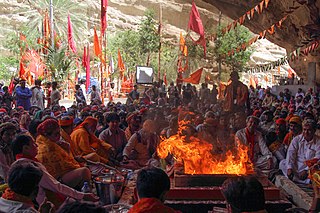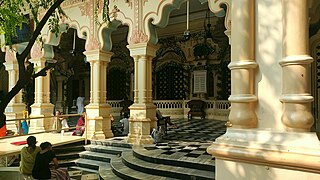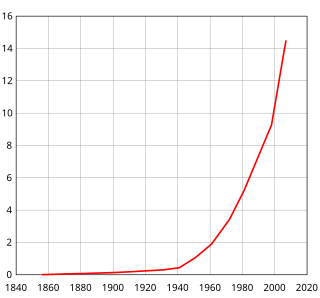| 1951 census of India | |
|---|---|
| General information | |
| Country | India |
| Results | |
| Total population | 361,088,090 (13.32%) |
| Most populous | Uttar Pradesh (60,274,800) |
| Least populous | Sikkim (138,093) |
The 1951 census of India was the ninth in a series of censuses held in India every decade since 1872. [1] It was also the first census after independence and Partition of India. [2] 1951 census was also the first census to be conducted under 1948 Census of India Act. The first census of the Indian Republic began on February 10, 1951. [3]
The population of India was counted as 361,088,090 (1000:946 male:female) [4] Total population increased by 42,427,510, 13.31% more than the 318,660,580 people counted during the 1941 census. [5] No census was done for Jammu and Kashmir in 1951 and its figures were interpolated from 1941 and 1961 state census. [6] National Register of Citizens for Assam (NRC) was prepared soon after the census. [7] [8] In 1951, at the time of the first population census, just 18% of Indians were literate while life expectancy was 32 years. [9] Based on 1951 census of displaced persons, 7,226,000 Muslims went to Pakistan (both West and East Pakistan) from India, while 7,249,000 Hindus and Sikhs moved to India from Pakistan (both West and East Pakistan). [10]
Separate figures for Hindi, Urdu, and Punjabi were not issued, due to the partition 1947 and fact the returns were intentionally recorded incorrect in states such as East Punjab, Himachal Pradesh, Delhi, PEPSU, and Bilaspur. [11]
| Rank | Language | 1951 census of India [11] | |
|---|---|---|---|
| Speakers | Percentage | ||
| 1 | Hindi, Urdu, Punjabi | 149,944,311 | 42.01% |
| 2 | Telugu | 32,999,916 | 9.24% |
| 3 | Marathi | 27,049,522 | 7.57% |
| 4 | Tamil | 26,546,764 | 7.43% |
| 5 | Bengali | 25,121,674 | 7.03% |
| 6 | Gujarati | 16,310,771 | 4.57% |
| 7 | Kannada | 14,471,764 | 4.05% |
| 8 | Malayalam | 13,380,109 | 3.69% |
| 9 | Odia | 13,153,909 | 3.21% |
| 10 | Assamese | 4,988,226 | 1.39% |
Hindus comprised 305 million (84.1%), Sikhs were 6.86 million (1.9%) and Muslims were 35.4 million (9.8%) in the 1951 census. [2] [12] [13] [lower-alpha 1] 1951 Indian census showed that there were 8.3 million Christians. [12] Hindus comprised about 73 per cent of the population of India before partition and just after independence, Independent India in (1947) had roughly around 85 per cent Hindus.
| Religious group | Population % 1951 |
|---|---|
| Hinduism | 84.1% |
| Islam | 9.8% |
| Christianity | 2.3% |
| Sikhism | 1.89% |
| Buddhism | 0.74% |
| Animism, others | 0.43% |
| Jainism | 0.46% |

India is the most populous country in the world with one-sixth of the world's population. According to UN estimates, India overtook China in having the largest population in the world with a population of 1,425,775,850 at the end of April 2023.

The Partition of India in 1947 was the change of political borders and the division of other assets that accompanied the dissolution of the British Raj in the Indian subcontinent and the creation of two independent dominions in South Asia: India and Pakistan. The Dominion of India is today the Republic of India, and the Dominion of Pakistan—which at the time comprised two regions lying on either side of India—is now the Islamic Republic of Pakistan and the People's Republic of Bangladesh. The partition was outlined in the Indian Independence Act 1947. The change of political borders notably included the division of two provinces of British India, Bengal and Punjab. The majority Muslim districts in these provinces were awarded to Pakistan and the majority non-Muslim to India. The other assets that were divided included the British Indian Army, the Royal Indian Navy, the Royal Indian Air Force, the Indian Civil Service, the railways, and the central treasury. Provisions for self-governing independent Pakistan and India legally came into existence at midnight on 14 and 15 August 1947 respectively.
The Punjabis, are an Indo-Aryan ethnolinguistic group associated with the Punjab region, comprising areas of eastern Pakistan and northwestern India. They generally speak Standard Punjabi or various Punjabi dialects on both sides.

Islam is India's second-largest religion, with 14.2% of the country's population, or approximately 172.2 million people, identifying as adherents of Islam in a 2011 census. India also has the third-largest number of Muslims in the world. The majority of India's Muslims are Sunni, with Shia making up around 15% of the Muslim population.

The Radcliffe Line was the boundary demarcated between the Indian and Pakistani portions of the Punjab Province and Bengal Presidency of British India. It was named after Cyril Radcliffe, who, as the joint chairman of the two boundary commissions for the two provinces, had the ultimate responsibility to equitably divide 175,000 square miles (450,000 km2) of territory with 88 million people.

Hinduism is the second largest religious affiliation in Pakistan after Islam. While Hinduism was one of the dominant faiths in the region a few centuries back, today Hindus account for only 2.14% of Pakistan's population or about 4.4 million people according to the 2017 Pakistani census, although Pakistan Hindu Council has claimed that there are 8 million Hindus living in Pakistan, making up 4% of the country's population. The Umerkot district has the highest percentage of Hindu residents in the country at 52.2%, while Tharparkar district has the most Hindus in absolute numbers at 714,698.

The Partition of Bengal in 1947, part of the Partition of India, divided the British Indian Bengal Province along the Radcliffe Line between the Dominion of India and the Dominion of Pakistan. The Bengali Hindu-majority West Bengal became a state of India, and the Bengali Muslim-majority East Bengal became a province of Pakistan.

The Dominion of India, officially the Union of India, was an independent dominion in the British Commonwealth of Nations existing between 15 August 1947 and 26 January 1950. Until its independence, India had been ruled as an informal empire by the United Kingdom. The empire, also called the British Raj and sometimes the British Indian Empire, consisted of regions, collectively called British India, that were directly administered by the British government, and regions, called the princely states, that were ruled by Indian rulers under a system of paramountcy. The Dominion of India was formalised by the passage of the Indian Independence Act 1947, which also formalised an independent Dominion of Pakistan—comprising the regions of British India that are today Pakistan and Bangladesh. The Dominion of India remained "India" in common parlance but was geographically reduced. Under the Act, the British government relinquished all responsibility for administering its former territories. The government also revoked its treaty rights with the rulers of the princely states and advised them to join in a political union with India or Pakistan. Accordingly, the British monarch's regnal title, "Emperor of India," was abandoned.

Hinduism is the largest religion in India. According to the 2011 Census of India, 966.3 million people identify as Hindu, representing 79.8% of the country's population. India contains 94% of the global Hindu population. The Indian subcontinent is the birthplace of four of the world's major religions: namely Hinduism, Buddhism, Jainism, and Sikhism—collectively known as Indian religions that believe Moksha is the most supreme state of the Ātman (soul). The vast majority of Indian Hindus belong to Shaivite and Vaishnavite denominations. India is one of the three countries in the world where Hinduism is the dominant religion.

The official religion of Pakistan is Islam, as enshrined by Article 2 of the Constitution, and is practised by approximately 96.47% of the country's population. The remaining 3.53% practice Hinduism, Christianity, Ahmadiyya Islam, Sikhism and other religions.

Punjabi Hindus are adherents of Hinduism who identify ethnically, linguistically, culturally, and genealogically as Punjabis and are natives of the Punjab region of the Indian subcontinent. Punjabi Hindus are the second-largest religious group of the Punjabi community, after the Punjabi Muslims. While Punjabi Hindus mostly inhabit the Indian state of Punjab, as well as Haryana, Himachal Pradesh, Delhi, and Chandigarh today, many have ancestry across the greater Punjab region, which was partitioned between India and Pakistan in 1947.

Since its independence in 1947, India has accepted various groups of refugees from neighbouring countries, including partition refugees from former British Indian territories that now constitute Pakistan and Bangladesh, Tibetan refugees that arrived in 1959, Chakma refugees from present day Bangladesh in early 1960s, other Bangladeshi refugees in 1965 and 1971, Sri Lankan Tamil refugees from the 1980s and most recently Rohingya refugees from Myanmar. In 1992, India was seen to be hosting 400,000 refugees from eight countries. According to records with the Union Ministry of Home Affairs, as on January 1,2021, there were 58,843 Sri Lankan refugees staying in 108 refugee camps in Tamil Nadu and 54 in Odisha and 72,312 Tibetan refugees have been living in India.
Punjab is home to 2.3% of India's population; with a density of 551 persons per km2. According to the provisional results of the 2011 national census, Punjab has a population of 27,743,338, making it the 16th most populated state in India. Of which male and female are 14,639,465 and 13,103,873 respectively. 32% of Punjab's population consists of Dalits. In the state, the rate of population growth is 13.9% (2011), lower than national average. Out of total population, 37.5% people live in urban regions. The total figure of population living in urban areas is 10,399,146 of which 5,545,989 are males and while remaining 4,853,157 are females. The urban population in the last 10 years has increased by 37.5%. According to the 2011 Census of India, Punjab, India has a population of around 27.7 million.
This is a list of States and Union Territories of India by Bengali speakers at the time of the 2011 Census.

Bengali Hindus are an ethnoreligious population who make up the majority in the Indian states of West Bengal, Tripura, Andaman and Nicobar Islands, Jharkhand, and Assam's Barak Valley region. In Bangladesh, they form the largest minority. They are adherents of Hinduism and are native to the Bengal region in the eastern part of the Indian subcontinent. Comprising about one-thirds of the global Bengali population, they are the second-largest ethnic group among Hindus after Hindustani Hindus. Bengali Hindus speak Bengali, which belongs to the Indo-Aryan language family and adhere to Shaktism or Vaishnavism of their native religion Hinduism with some regional deities. There are significant numbers of Bengali-speaking Hindus in different Indian states. According to the census in 1881, 12.81 per cent of Bengali Hindus belonged to the three upper castes while the rest belonged to the Shudra and Dalit castes.

Karachi is the largest and most populous city in Pakistan. The population of Karachi is estimated to be around 16 million (16,093,786) in 2020. The population and demographic distribution in the megacity has undergone numerous changes over the past 150 years. On 14 August 1947, when it became the capital city of Pakistan, its population was about 450,000 inhabitants However, the population rapidly grew with large influx of Muslim refugees after independence in 1947. By 1951, the city population had crossed one million mark. in the following decade, the rate of growth of Karachi was over 80 percent. Today, the city has grown 60 times its size in 1947 when it became the country's first capital. Although, Islamabad remains the nation's capital since the 1960s, the city's population continues to grow at about 5% per annum, largely thanks to its strong economic base.
The Mirpuri diaspora constitutes individuals with an origin in the Mirpur District of Azad Kashmir, Pakistan, now living outside that district. Migration from Mirpur started occurring in the 1920s, when many Mirpuris left for Bombay to work on merchant ships. During the partition of British India in 1947, many Mirpuri Hindus and Mirpuri Sikhs were forced to flee to cities in the princely state of Jammu and Kashmir. The construction of the Mangla Dam by the Pakistani Government in the 1960s caused many of Mirpuri Muslims to migrate to the United Kingdom to work as labourers.

Islam is a minority religion in Punjab, India followed by 535,489 people constituting about 1.93 percent of the state population out of 27.7 million population as of 2011 census report.
An illegal immigrant in India is a foreigner who has entered India either without valid documents or who initially had a valid document, but has overstayed beyond the permitted time, as per the general provisions of the Citizenship Act as amended in 2003. Such persons are not eligible for citizenship by registration or naturalisation. They are also liable to be imprisoned for 2–8 years and fined.

After the Partition of India, during October–November 1947 in the Jammu region of the princely state of Jammu and Kashmir, many Muslims were massacred and others driven away to West Punjab. The killings were carried out by extremist Hindus and Sikhs, aided and abetted by the forces of Maharaja Hari Singh. The activists of the Rashtriya Swayamsevak Sangh (RSS) played a key role in planning and executing the riots. An estimated 20,000–100,000 Muslims were massacred. Subsequently, many non-Muslims were massacred by Pakistani tribesmen, in the Mirpur region of today's Pakistani administered Kashmir, and also in the Rajouri area of Jammu division.